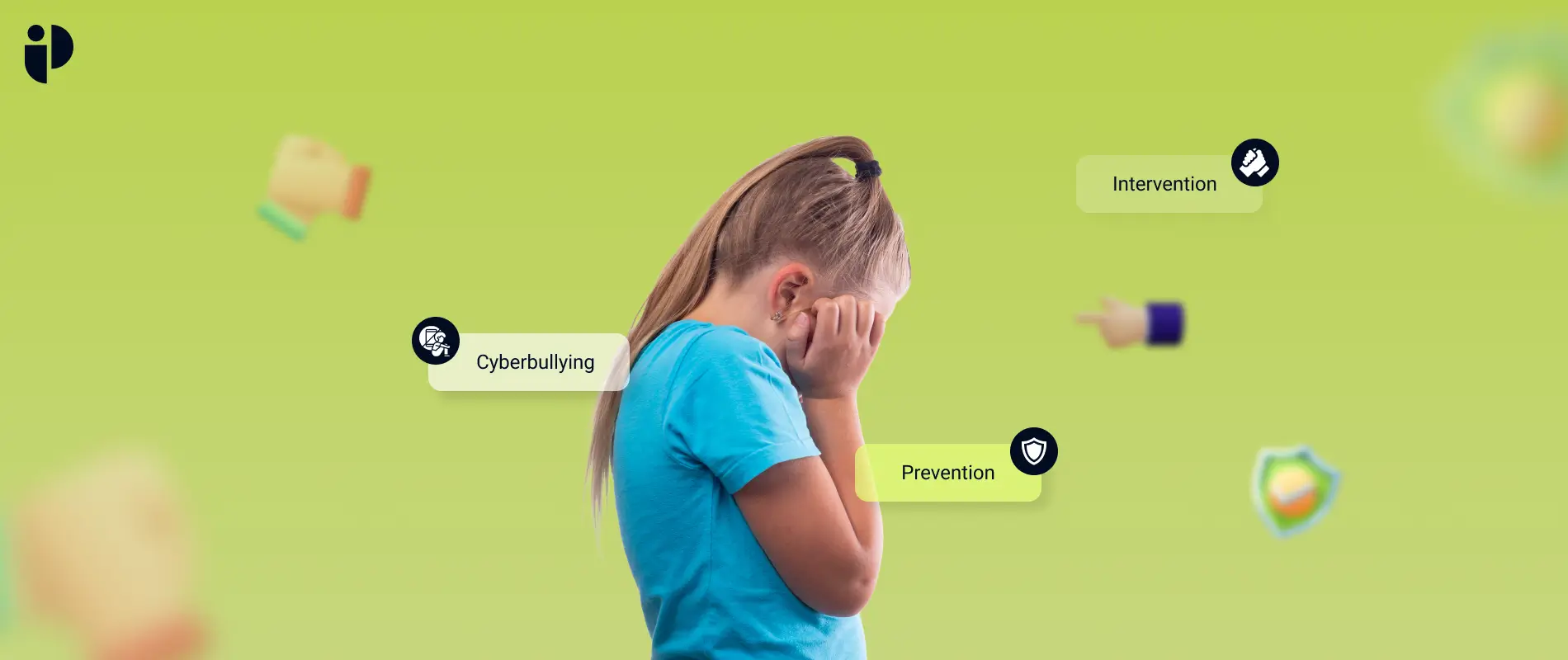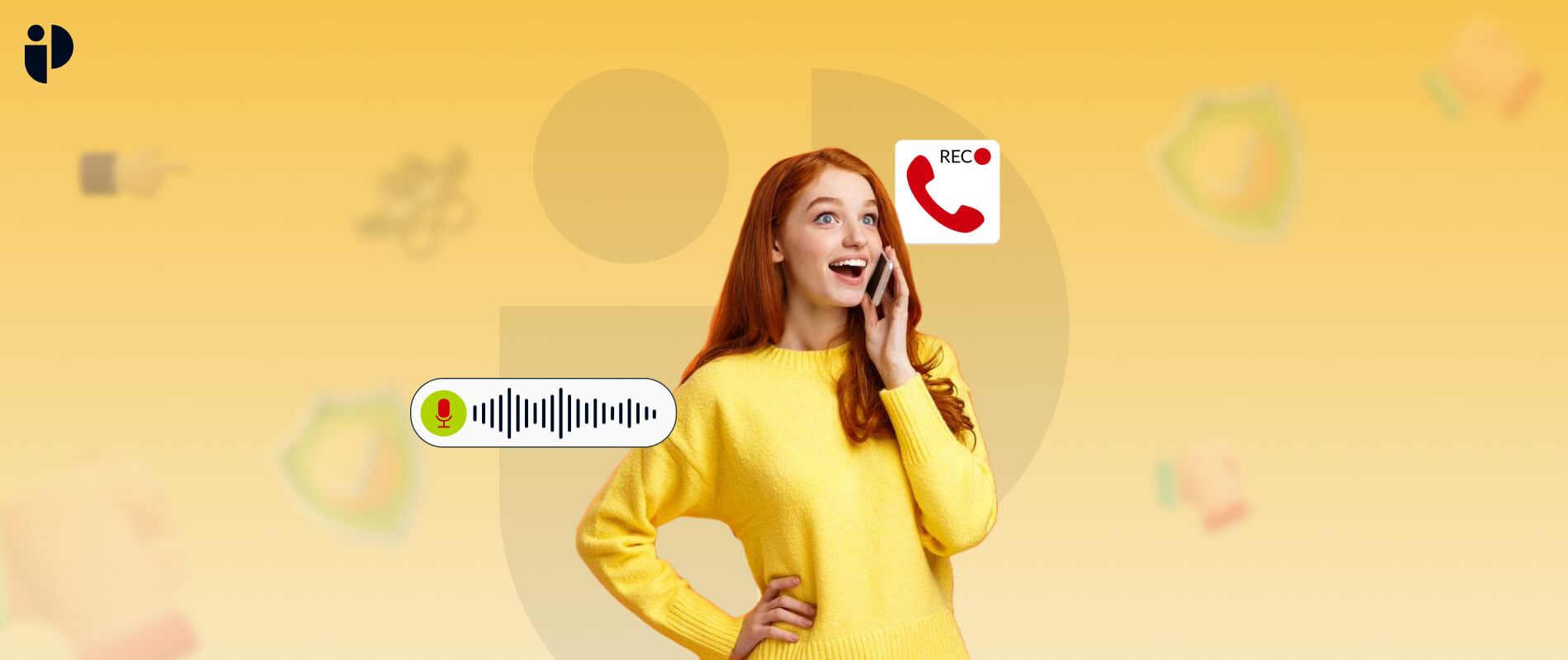Cyberbullying has become one of the major concerns of this digital age. Unlike traditional bullying it occurs online instead of being face to face. It is illusive and may occasionally even be more destructive as it takes place online.
What is Cyberbullying?
According to UNICEF, bullying committed online is known as cyberbullying. Social media, chat services, gaming platforms, and mobile devices are all potential venues for cyberbullying. It is a pattern of behavior meant to frighten, infuriate, or embarrass the target.
There are some other terms used for cyberbullying including, cyber harassment, trolling, flaming, online bullying, social media abuse and many more.
Examples of cyberbullying comprise:
- Providing false information about someone or publishing humiliating pictures or videos of them on social media.
- Sending insulting, threatening, or abusive messages, photographs, or videos through messaging services.
- Pretending to be someone else and sending nasty messages to other people on their behalf or through fictitious accounts.
Bullying that takes place in person and online frequently coexist. However, cyberbullying leaves a digital trail—a record that may be helpful and offer proof to put an end to the abuse.
Types of Cyberbullying
By the Social Media Victim Law Center, cyberbullying has many categories which includes;
Harassment
When a victim receives frequent and abusive internet communications, it is considered harassment. Threats may be contained in these texts.
Exclusion
Someone might be purposefully excluded from an online group or message thread by a cyberbully. A victim may feel lonely and unhappy as a result.
Cyberstalking
A cyberbully who engages in cyber stalking keeps a careful eye on their victim’s online activity. The victim and their loved ones may also come under false charges and threats from the bully. The victim, along with their loved ones, may be at risk if the stalking behavior escalates into the real world.
Both online and offline stalking are regarded as serious crimes.Victims have the option to seek a restraining order against their perpetrators in any circumstance, while offenders may face probation or imprisonment.
Doxxing
Doxxing, also known as “doc-dropping,” is the malicious sharing online of private information about a person by a cyberbully in order to annoy or threaten a victim. Personal data like a person’s home address, their place of attendance at school, or their social security number fall under this category.
Outing
When a cyberbully publicly discloses a person’s gender identity or sexual orientation without that person’s consent, it is known as outing that person on social media. Bullying occurs with the intention of humiliating or degrading the victim.
Denigration
By transmitting, uploading, or publishing false material about a victim online, a cyberbully denigrates the person. Typically, denigration takes the form of malicious rumors and gossip about a victim.
Trolling
Cyberbullies can troll victims by making disparaging online remarks about them in the intention of harming these people, albeit not all trolling is deemed cyberbullying.
Flaming
Flaming is the act of publicly criticizing a victim or sending them offensive messages. A victim of cyberbullying is flamed in an effort to provoke them into an online altercation.
Dissing
A cyberbully insults a person by disseminating unkind rumors about them. The bully does this through open posts or private messaging with the aim of harming the victim’s reputation or interpersonal connections.
Fake Profiles
Cyberbullies are able to create phony internet personas on behalf of their targets. Without the victims’ permission, they can publish fraudulent content using these accounts in the identities of their victims.
Trickery
A cyberbully may get friendly with a victim to the point that the victim feels at ease disclosing critical information. The information the victim reveals is subsequently made public by the bully in an effort to degrade, defame, or otherwise hurt the victim.
Impersonation
By making posts under the victim’s name on social media and in chat rooms, a cyberbully can impersonate a victim. By doing this, a victim runs the risk of receiving retribution from others as a result of the bully’s online comments.
Catfishing
A cyberbully uses catfishing to prey on their victim’s feelings. When a victim is being cyberbullied, the aggressor develops a false online identity and poses as someone else. The bully can then interact with a victim while posing as them, starting an online relationship.
The victim can eventually come to trust the internet user and divulge private information to them.The cyberbully might then utilize this information to expose or humiliate the victim by making them look bad.
Cyberbullying Stat
According to IPSOS conducted surveys 25% of the world hasn’t even heard about what cyberbullying is though the awareness about it is increasing day by day.
Here you can see the graphical analysis of that;
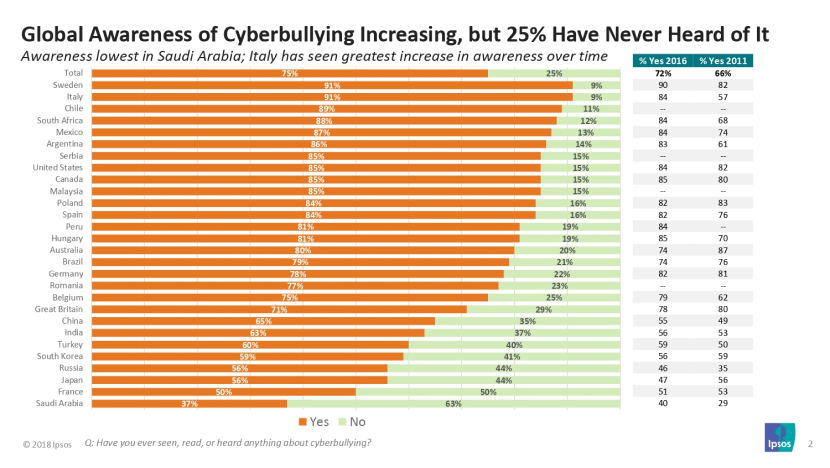
Reported Cases of Cyberbullying
According to a survey, each year there are varying numbers of reported occurrences of cyberbullying, and the most recent year’s exact data might not be accessible. However, certain data offer information on the frequency of cyberbullying.
Recent studies show that 10–20% of young adults who reported experiencing cyberbullying frequently experienced it, or around half of all young adults, some type of cyberbullying. Furthermore, 69% of people, according to estimates, have acted abusively toward others online.
The prevalence of cyberbullying varies among social media platforms, with YouTube having the highest likelihood of this for young users (79%), followed by Snapchat (69%), and TikTok with a smaller number.
By IPSOS,
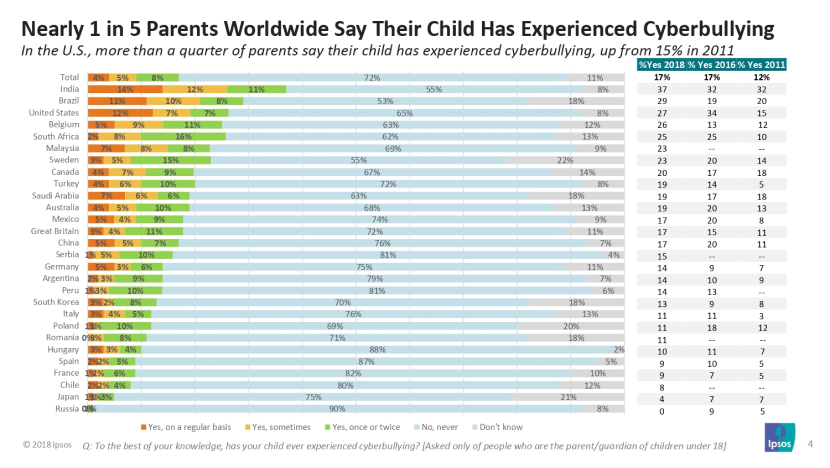
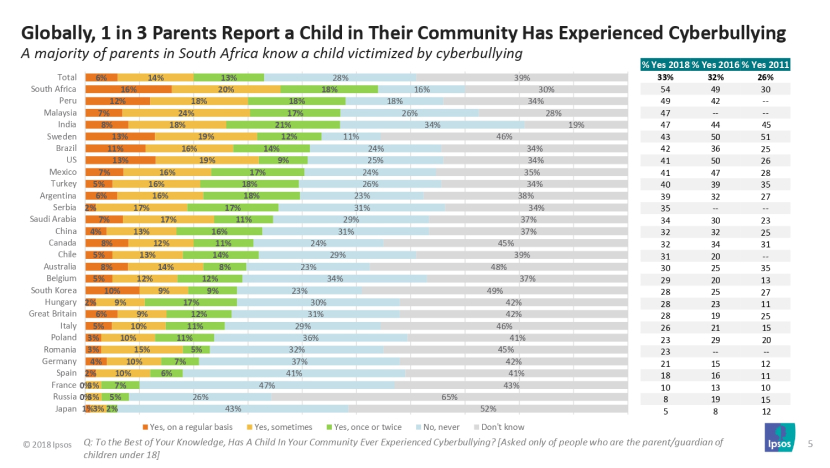
Most Common Platforms for Cyberbullying
The most common platform for cyberbullying is social media. People get harassed by the messages, videos, calls and fake profiles.
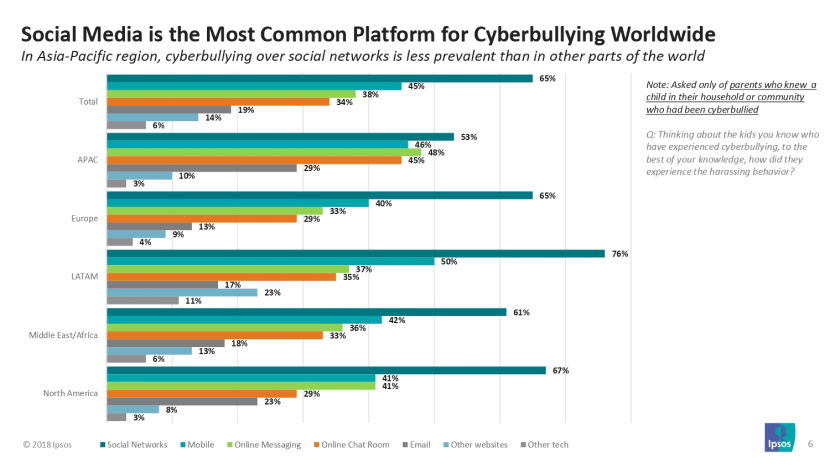
Most People Involved in the Cyberbullying
According to reports , the people usually involved in cyberbullying are known to the victim either classmates or some other known person.
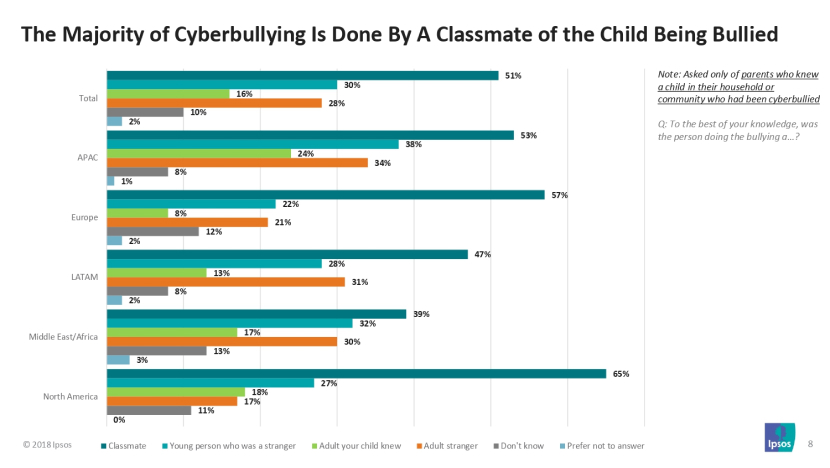
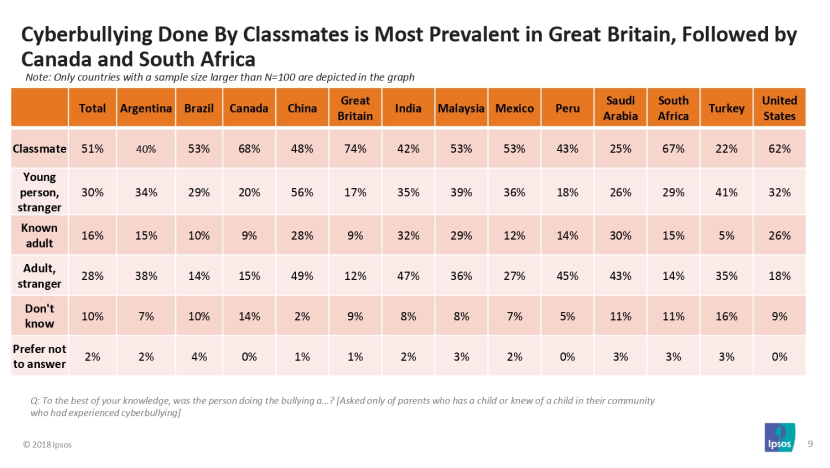
Signs of Cyberbullying
According to Sameer Hinduja, a Ph.D Assistant Professor in the Department of Criminology and Criminal Justice at Florida Atlantic University & Justin W. Patchin, a Ph.D assistant Professor of Criminal Justice in the Department of Political Science at the University of Wisconsin‐Eau Claire.
There are numerous signs that your child may be a victim of cyberbullying. You should keep a tight eye on how they use technology (such as computers and smartphones) and keep an eye out for any unusual behavior.
For instance, there can be a problem if your youngster usually likes using the computer but suddenly loses interest in doing so.
Similar to this, you may need to look into it if your youngster appears to be entirely engrossed in online communication at all hours of the day and night.
When you find your child participating in inappropriate online conduct, use common sense and age-appropriate penalties.
Signs of a child victim of cyberbullying
- Abruptly stops using the computer.
- Shows signs of anxiety or jitteriness when a text, instant message, or email arrives.
- Looks uneasy about going to school or being outside in general.
- Seems angry, depressed, or frustrated after using the computer.
- Avoids conversations about what they are doing on the computer.
- Withdraws abnormally from regular friends and family members online.
Signs if your child is involved in cyberbullying
- Uses the computer at all hours of the night.
- Gets unusually upset if unable to use the computer.
- Laughs excessively while using the computer.
- Avoids conversations about what they are doing on the computer.
- Switches screens or closes programs quickly when you walk by.
- Uses multiple online accounts or uses an account that is not their own.
You can read more: 7 Signs Indicating Your Child is Being Bullied
Preventive Measures To Avoid Cyberbullying
Teens can take a number of actions to stop cyberbullying.
- Renew Your Knowledge
You must fully comprehend what cyberbullying is if you want to stop it from happening.
Find out what defines cyberbullying and where and how it is most likely to happen by doing some research. Discuss with your buddies what they are seeing and feeling.
- Be Secure With Your Password
Keep your password and other sensitive data hidden from inquisitive eyes. Never put passwords or other personal information in plain sight.
Additionally, even your best buddy should never be given this information. If others are aware of it, change it right away!
- Remain “Pg” In Photos
Be sure it’s something you would want your parents, grandparents, and the rest of the world to view before uploading or sharing that hot picture of yourself.
This image can be used as leverage by those who wish to harm you in order to make your life miserable.
- Always Disregard Unidentified Or Unsolicited Message
Never respond to messages (emails, texts, Facebook messages, etc.) from strangers or from someone you know has a history of bullying others. Don’t read them; just delete them.
If opened, they can be infected with viruses that damage your device immediately. Additionally, never click on links to websites that are supplied to you by an unknown party.
These might also be infected with a virus used to gather your private or personal information or to set up a backdoor.
- Always Log Out Your Accounts
For your own convenience, avoid saving passwords in form fields on websites or in your web browser, and never leave your computer or mobile device logged in. Don’t even give someone an opportunity to use your smartphone to pretend to be you online.
The next individual who uses the library computer could access your account and cause you serious difficulties if you neglect to log out of Twitter before leaving.
- Stop Before Posting
Post nothing that might damage your reputation. Based on how you appear to them online, people will evaluate you.
On the basis of this, they will also offer or reject your chances (jobs, scholarships, internships).
- Raise Conscience
Start a club, a movement, a campaign, or a gathering to raise awareness about cyberbullying. Even though you may be aware of what it is, we won’t be able to effectively stop it from happening until others are too.
- Configure Private Controls
Only allow trusted pals access to your online profile. The majority of social networking sites, including Facebook and Instagram, let you share certain information with friends only, but these settings need to be set up in order to provide the highest level of security. Additionally, don’t accept friend requests from random people on Snapchat.
- Search Yourself On “Google”
Conduct routine searches for your name on all popular search engines (such as Google, Bing, and Yahoo).
Take steps to get any personal information or content removed if it emerges that could be used by someone to target you.
- Avoid Cyber-Hurting Others
You should treat others the way you want to be treated. You contribute to the issue by being a jerk to people online.
Do not lower yourself to it; you are better than that. Set higher goals and set an example for others. It is really important, both now and in the future.
Role of Parents in Prevention of Cyberbullying
The increasing rates of cyberbullying has not even solved this issue and parents still have the complaints about improper systems to solve this problem. Here you can see the results of survey conducted by IPSOS,
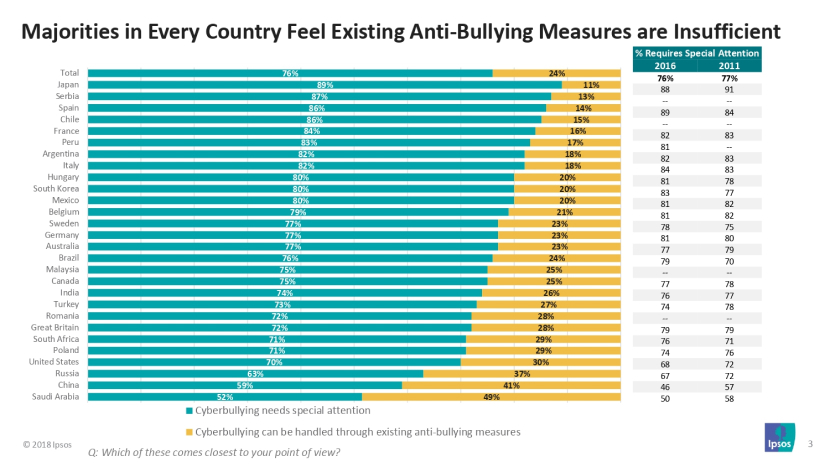
Thus here are some ways parents can play their role in preventing cyberbullying.
Accessible Communication
Encourage honest and unprejudiced conversation with your kids. Encourage them to discuss their positive and negative online experiences. Make sure they are aware that they can contact you if they have any problems.
Establish Ground Rules
Establish explicit rules for screen time, online conduct, and responsible technology use. Whether online or offline, emphasize the value of treating people with respect and sensitivity.
Security Settings
How to use privacy settings on social media sites and other internet accounts should be taught to your kids. Make sure they are aware of how to protect their personal data and control who has access to their profiles.
Monitoring Software
Monitoring softwares is the best way to keep your kids safe from cyberbullying. You can keep an eye on their activities like messages, calls, location etc. This is how you can save your kids from being involved in cyberbullying or becoming a victim of that.
Interventions for Cyberbullying
It’s crucial to step in when there is cyberbullying in order to put a stop to the damaging behavior and offer support to the victims. There are several actions that parents, educators, and the community can take to effectively handle cyberbullying events. The following are some crucial intervention tactics:
Consider and Encourage
When a youngster reports being cyberbullied, pay close attention to what they say and offer them emotional support. Ensure them that you are there to support them and that they are not facing this problem alone.
Documentary Proof
Keep track of instances of online harassment, including screenshots of unpleasant messages, comments, or articles. This evidence may be useful when bringing up the problem with law enforcement or school administrators.
Block and Report
Encourage the victim to block the online bully on chat or social media sites. Additionally, inform the platform administrators about the inappropriate content. The majority of social media networks include ways for users to report abusive behavior.
File a Complaint
Consider engaging law police in extreme situations where cyberbullying involves threats, harassment, or questionable behavior. They can look into the matter and, if necessary, file a lawsuit.
Monitor and Follow-up
Keep an eye on the situation at all times to make sure that cyberbullying ends and doesn’t get worse. Maintain contact with the victim to offer continuing support and make sure they’re okay.
Summary
Cyberbullying is a significant social issue affecting people’s mental health and well-being. The digital world offers opportunities for connection and information, but can also cause harm. As we navigate this digital frontier, we have a responsibility to promote a secure online environment.
Recognizing cyberbullying symptoms and taking proactive preventive measures, such as communication, education, and boundary-setting, is crucial. Support and action are essential when cyberbullying arises, as everyone has a say in shaping the online world.
The fight against cyberbullying aims to create a brighter, more compassionate digital future where connection, understanding, and support triumph over harassment and intimidation.
Also Read:
